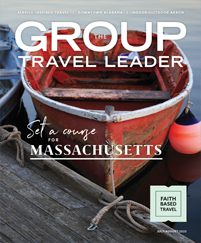 Courtesy Adventures Unlimited
Courtesy Adventures Unlimited
Groups traveling in the coastal areas of Texas, Louisiana, Mississippi, Alabama and Florida have many types of attractions and activities from which to choose, including those that are historical, cultural and pleasing to the palate.
Spending time outdoors on the coast can mean strolling through finely manicured gardens to careening down a zip line above a dense tree canopy. Out on the water, you can raft down a tidal creek or take a boat tour into the Gulf of Mexico to learn about the shrimp, stingrays and myriad other creatures that make their home in the warm waters.
Next time your group travels to the Gulf Coast, make sure you plan a visit to one of these natural areas.
Adventures Unlimited
Pensacola, Fla.
The forests, wetlands and creeks surrounding Pensacola on Florida’s Gulf Coast provide a great setting for outdoor exploration. At Adventures Unlimited, groups can enjoy fast- or slow-paced outdoor activities.
 |
| Courtesy Adventures Unlimited |
Located on Clear Water Creek, Adventures Unlimited’s territory is surrounded by the Blackwater River State Forest, which consists of oaks, junipers, cypresses, dogwoods and pine trees. Visitors can choose an expedition like canoeing or tubing on the water or take to the trees for a more high-adrenaline experience.
“There’s a lot that you can do out on the water,” said the company’s Suzanne Roberts. “Tubing requires zero skill — you’re transported upstream and then float back down to Adventures Unlimited. You can float a cooler with your lunch down with you.”
Tubing is a wet experience, so visitors looking to stay dry can choose guided canoe trips or kayaking excursions in one- or two-seat vessels. The trips range in length from 90 minutes to four hours and take participants to various parts of Coldwater Creek and Blackwater River.
This year, the company is offering another high-flying activity called Zip Adventures, which takes people on a tour through the forest canopy.
“It’s a set of 13 zip lines that go over the woods,“ Roberts said. “People that go on that will get something of a nature lesson about indigenous plants and animals and also a history lesson about what they’re going over. You get a really different perspective from being above the treetops.”
Creole Nature Trail
Lake Charles, La.
Louisiana’s coastal areas have a mix of bayous, beaches and other habitats, and on the Creole Nature Trail, visitors can see several of them.
 |
| Courtesy Lake Charles CVB |
“The Creole Nature Trail is a 180-mile driving trial,” said Katie Harrington, public relations manager at the Lake Charles Convention and Visitors Bureau. “It’s a National Scenic Byway, and it’s definitely a treasure. There’s absolutely no cost to anyone to tour — you just take a drive.”
Along the driving trail, numerous boardwalks and other scenic spots give groups a chance to get out and walk through the environment to get an appreciation for the flora and fauna of the area. On the Pinto Wildlife Drive, visitors can see alligators, birds and other swamp creatures from a number of walkways that lead out over the marsh.
Another popular attraction along the trail is the Cameron Prairie National Wildlife Refuge Visitors Center, which features exhibits on marsh life and some observation platforms for wildlife viewing. At the southernmost point of the trail, 19 miles of uninterrupted beaches give groups a number of activity options.
“One of the best things you can do is go shelling on the beach,” Harrington said. “The other big thing to do is crabbing. All you need is a string and some raw meat. You tie the string around the meat and throw it in the water. The crabs catch on, and then you scoop them up with a net.”
Alligator Alley
Summerdale, Ala.
On 20 acres of natural cypress swampland not far from Mobile, Ala., Alligator Alley is the best place on the Gulf Coast for reptile lovers to get up close and personal with alligators.
 |
| by Brian Jewell |
“We’ve got 173 alligators that have free reign of the swamp,” said Alligator Alley guide Evan Wheeler. “On any given day, I see 60 to 70 of them.”
The gator farm was founded in 2003 as a refuge for large alligators that had been removed from populated areas of Georgia and Florida. In 2004, it opened as a tourist attraction, and today, groups can visit to learn all about these unusual creatures.
Guides at Alligator Alley lead visitors along the creek banks to places where the alligators lurk, and they feed the alligators pork fat and other chunky morsels of meat as guests look on from behind the safety of a wooden fence. During the demonstrations, the guides point out some of the alligators’ characteristics.
“They only need 10 percent of their body weight in food every year,” Wheeler said. “Some alligators only eat once a year. In the winter, they can drop their heart rate to 10 beats per minute, so they can take a breath and stay underwater for hours.”
After the demonstrations and the opportunity to hold a baby alligator, guests continue their tour on a system of boardwalks constructed over the cypress swamp. Dozens of alligators can be seen along the way, including Captain Crunch, a 13-and-a-half-foot behemoth that holds the world record for the most powerful bite of any alligator in captivity.
Biloxi Shrimping Trip
Biloxi, Miss.
For a time, the Gulf waters off the Mississippi coast were some of the country’s largest sources of shrimp and other fresh seafood. Today, groups visiting the Biloxi area can learn about the local seafood history and see marine creatures up close on the Biloxi Shrimping Trip.
 |
| Courtesy Biloxi Shrimping Trip |
“We’ve been in business since 1955,” said Brandy Moore, who runs the shrimping expeditions with her husband, Mike. “We do a 70-minute marine adventure tour. We talk about seafood and maritime history on the Gulf Coast.”
The excursions take place on a 40-foot, double-decker tour boat built by the company’s founder in 1953 and maintained in its original condition ever since. The boat holds 49 people, making it the perfect size for a motorcoach group.
During the tour, Brandy and Mike demonstrate traditional shrimping, casting trawler nets into the water and then dragging them behind the boat for about 20 minutes. When the nets are hauled back in, they are full of all kinds of sea creatures, such as shrimp, stingrays, puffer fish, jellyfish, catfish and squid.
“We keep it educational, but it’s fun,” Mike said. “We explain each fish and what it does in the area. There’s wildlife coming up to the boat, and you can feed the birds while you’re on the tour.”
The company also offers a shallow-water fishing trip for smaller groups that want a hands-on experience, as well as a two-hour music cruise at sunset.
Moody Gardens
Galveston, Texas
With more than 242 acres on Galveston Island, Moody Gardens preserves the best of local habitats for visitors and gives them the chance to see other plants and wildlife from around the world.
 |
| Courtesy Moody Gardens |
“Our founder wanted to create a tourist destination as a way of giving back to the island,” said Jerri Hamacheck, public relations representative for Moody Gardens. “We have lush gardens all over the property, which we planted because it wasn’t so beautiful in this spot before. We wanted to showcase the gardens and provide a therapeutic experience as you walk through.”
Groups visiting Moody Gardens can have a private meal or luau on the white sand beach at the on-site freshwater lagoon. Paddlewheel boat cruises are also available, taking visitors out on 45-minute tours of the Gulf of Mexico several times a day and at sunset.
For a more exotic experience, Moody Gardens features three large pyramids, which contain an immersive rain-forest habitat, a large aquarium and a museum exhibit gallery.
“Our aquarium pyramid is one of the largest aquariums in the country,” Hamacheck said. “You’re going to see seals, sharks and five kinds of penguins. You can walk through an acrylic tunnel and see the sharks swimming overhead. You learn about nature, and there are great conservation messages throughout.”
The rain-forest pyramid will be open this summer but is undergoing an extensive enhancement project. When it is finished in May 2011, the exhibit will feature a full complement of plants, fish, birds, reptiles and mammals from rain forests of Asia, Africa and the Americas.












